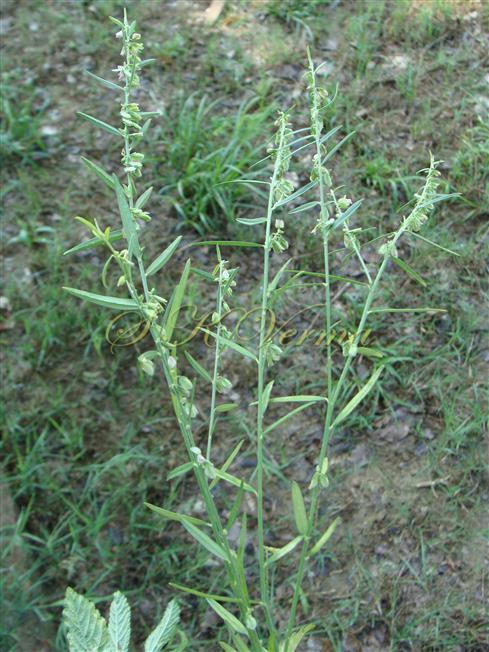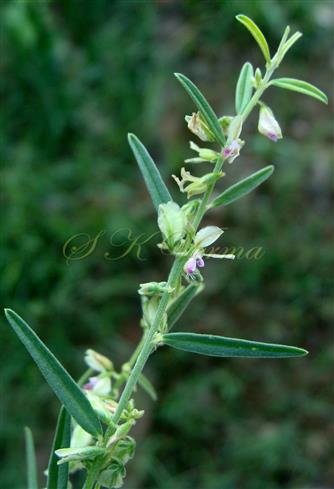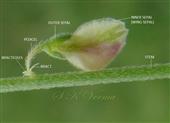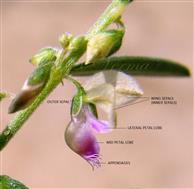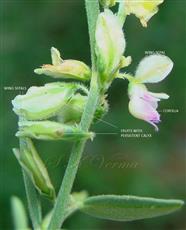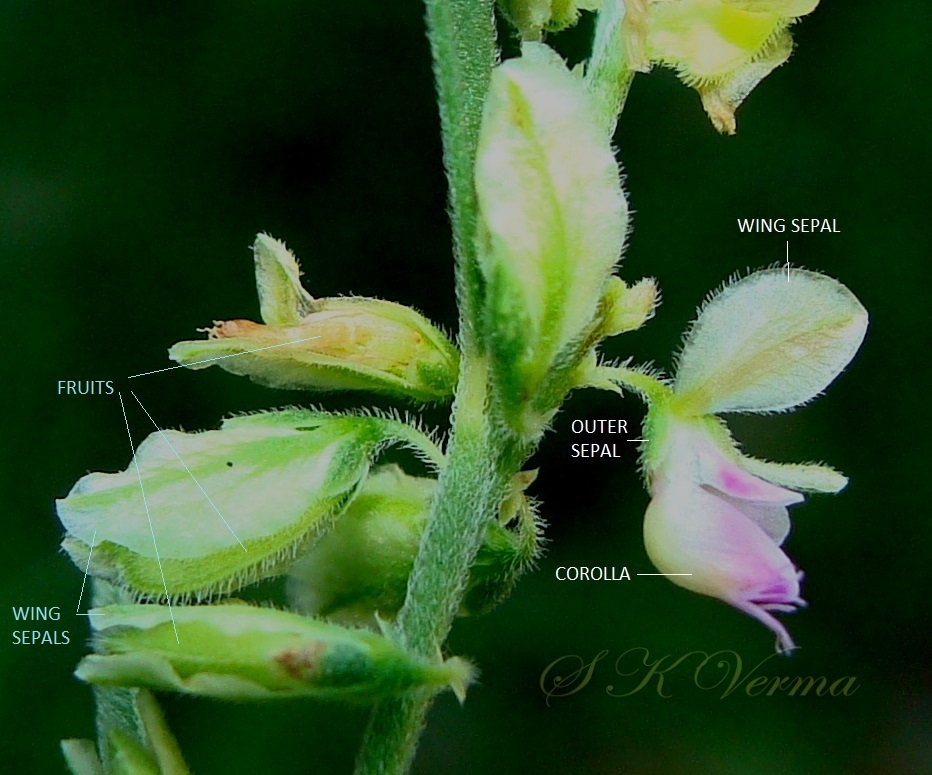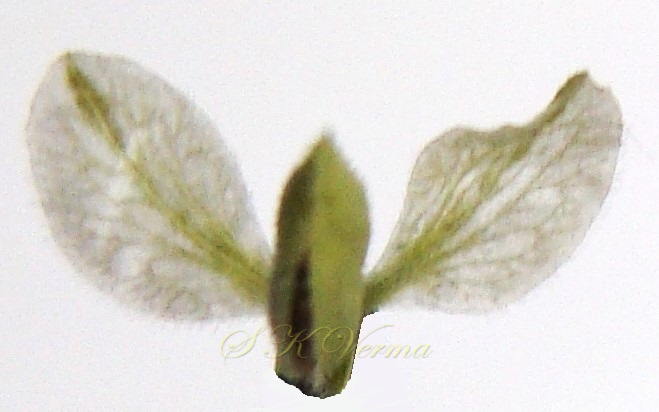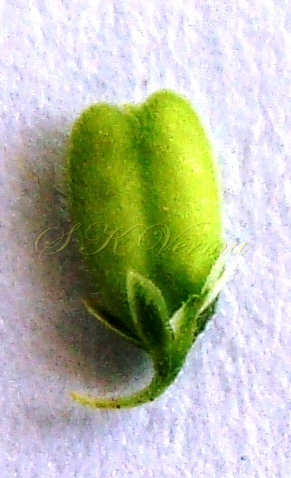POLYGALA
Polygala Tourn. ex L., Sp. Pl. 2: 701. 1753; Gen. Pl. ed. 5: 851. 1754; Boiss., Fl. Or. 1: 468; 1867; Bennett in Hook. f., Fl. Brit. India 1: 200. 1875; Chodat, Mem. Soc. Phys. Hist. Nat. Geneve, 31(2, No. 2): 1-500. 1893; Cooke, Fl. Bombay 1(1): 59. 1901; Collett, Fl. Siml. 42. 1902; ed. 2: 42.1921 (Reprint 1980); Kashyap, Fl. Lahore Dist. 35: 1936; Fl. China @ eFloras.org 11: 1141; Fl. Pak. @ eFloras.org
Annual or perennial herbs, shrubs or small trees, rarely woody climbers, glabrous or pubescent with up curved hairs. Leaves simple, usually alternate, exstipulate, petiolate; leaf blades papery or subleathery, margin entire, glabrous or pilose. Racemes terminal, axillary or extra-axillary. Flowers bisexual, zygomorphic, hypogynous; bracts 1-3, persistent or caducous; bracteoles present. Sepals 5, unequal, persistent or caducous, in 2 whorls: outer 3 small, inner 2 large and petaloid. Petals 3, connate in lower half, white, yellow or purple- red; keel boat-shaped, cucullate or helmet-shaped enclosing stamens and style, apex with often highly divided appendage. Stamens usually 8, +/- into a trough-shaped staminal sheath and adnate to petals; anthers basifixed, monothecous or bithecous, dehiscence by terminal pore or slit. Ovary compressed, 2-locular, 1 ovule per loculus; style 1, erect or curved; stigmas 1 or 2. Fruit capsular, compressed, often winged. Seeds 2, usually black, ovoid, rounded or cuneate, glabrous or +/- pilose, strophiole usually 3-lobed.
669 species
Polygala erioptera
Polygala erioptera DC., Prodr. 1: 326. 1824; Boiss., Fl. Or. 1: 469; 1867; Bennett in Hook. f., Fl. Brit. India 1: 203. 1875; Chodat, Mem. Soc. Phys. Hist. Nat. Geneve, (2, No. 2): 342. 1893; Cooke, Fl. Bombay 1(1): 60(63). 1901; Fl. Pak. @ eFloras.org; P. erioptera var. vahliana (DC.) Chodat, Mem. Soc. Phys. Hist. Nat. Geneve, 31: 345. 1893; Karthik et al. J. Bomb. Nat. Hist. Soc. 80: 64. 1985; Banerjee in Sharma & Balakr., Fl. Ind. 2: 467. 1993; keralaplants.in; P. vahliana DC., Prodr. 1: 325. 1824.
Annual, erect herb, branched, up to 50 cm long, usually with all vegetative parts densely pubescent with short recurved hairs. Leaves alternate, subsessile, linear-elliptic, linear-obovate, oblong-elliptic or oblanceolate, narrowed at base, margin revolute, acute or obtuse, 0.6-4 cm x 1-6 mm, glabrescent above, tomentose beneath, 1-nerved, lateral veins indistinct. Flowers zygomorphic, bisexual, hypogynous, pink, ca. 5 mm long, in racemes or solitary, lateral, axillary or extra axillary, racemes usually lax or dense, shorter than leaves, up to 3 cm long; bracts small, shorter than pedicels, persistent; 1.5-2 mm long, pubescent. Sepals 5, persistent; outer 3 sepals ovate-lanceolate to elliptic, acute, unequal, 1.5-2.5 mm x 0.7-1.2 mm, upper larger than the lower two, hyaline at margin, densely hairy outside; inner 2 sepals (wing sepals) obliquely elliptic, elliptic-obovate or oblong, obtuse or subobtuse, sometimes apiculate, 4-5 mm x 2-2.7 mm, usually medially green, nerves anastomosing leaving a hyaline zone at margin, sparsely pubescent outside; enlarged and membranous in fruit. Petals 3, connate at base, pink; lateral lobes deltoid or ovate, subacute, ca. 3 mm x 4 mm; mid lobe keeled, 2.5-4.5 mm long, crested with 2 apical bundles of filiform pale pink appendages. Stamens 8, monoadelphous; staminal sheath free or slightly adnate to mid lobe of petals, ca. 1.5 mm long mm long. Ovary ovoid, ca. 1 mm long, compressed, 2- locular, 1 ovule per loculus, pilose; style curved, up to 3 mm long, broad in middle; stigma capitate. Capsule oblong or ellipsoid, obliquely notched, winged, margined, pubescent. Seeds 2, oblong, ca. 3 x 1.5 mm, densely pilose, black; caruncle ca. 0.7 mm long, bristly and membranous, 3-fid, appendages minute and membranous.
Common Names: Woolly-winged Milkwort
